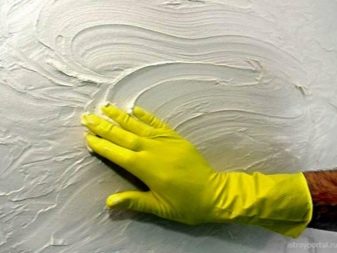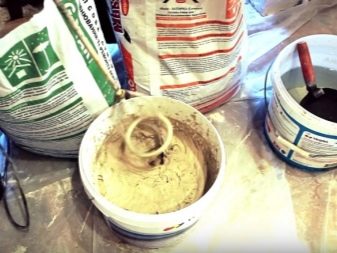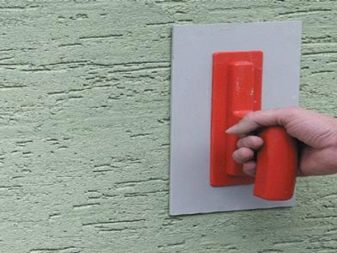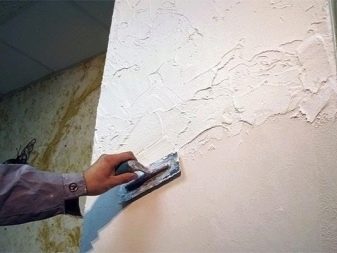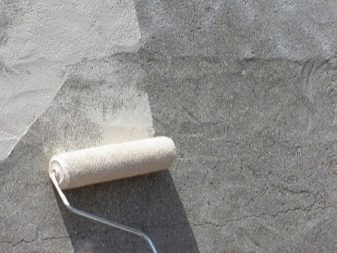Decorative plaster "under the tree": materials and ways to create different effects
Taking into account all the advantages and technological advantages of such a popular material as decorative plaster, any specialist in the field of interior decoration of premises immediately thinks about the breadth of choice and the variety of effects that can be obtained with this composite. Of undoubted interest in this series are decorative plaster "under the tree."
Special features
A very durable finish that imitates natural material reproduces the natural appearance of wood with such convincingness that it is difficult to distinguish it from real wood.Naturally, this effect takes place if all the work is done by the master at the proper professional level. As for the price, such plaster is much cheaper than wooden panels.
This design can be done to create the effect of tree bark. by imitation of a surface with natural damage or in the form of effect boards laid close together. It is also possible transverse pattern in the form of a cut or a panel with the reproduction of wood texture.
Each of these cases requires the use of dissimilar techniques, tools and decorative plaster, so you should make a choice in advance in favor of the option you like. In addition to working directly with the solution, to obtain the desired color you should also choose the right color.
The gel or dye in the bucket may have the desired shade, but after applying to the walls the colors may lose the desired saturation, showing a very different result.
Composition
Decorative plasters are among the safe finishing materials made from natural raw materials. To their composition there is a binding basis, due to which the coating hardens.The base of acrylic polymers allows you to get a textural or glossy surface.
This is followed by a filler designed to form a decorative “wooden” illusion. Particularly popular with consumers are such mixtures, which are based on lime, gypsum and quartz sand.
The composition of these plasters also include additives, which affect the color, quality and consistency of the finished solution. As for the solvent, it is ordinary water.
Universal properties and a wide range of varieties of plaster, stylized wood, make it possible to apply it in the design of interior design in any stylistic direction.
Application and varieties
Through this kind of material, it is possible to cover the wall surfaces inside the house, as well as during exterior facade work. The appearance of the finished coating with imitation of wood of various species is so natural that at first glance it is difficult to immediately find the differences between the plastered surfaces and the walls made of real wood. Therefore, the reproduction of natural material through imitation finishing technologies in the interior of a house or apartment is so attractive to people.
To obtain a surface indistinguishable from the cut of a tree, serious professional skills are required. It is necessary to correctly use the spatulas, as well as to know the drawing of the wood structure - without this, independent work simply does not make sense. However, if you want to do the finishing work with your own hands, the homeowner can take a couple of lessons from a professional master and successfully cope with the task.
In order to give naturalism to a drawing, one should master the skills:
- images of tree bark;
- images of imitation of a wooden fence;
- have the ability to reproduce the transverse sawing of the tree trunk;
- master the demonstration of traces of "work" of insect pests, as well as the creation of wall sections in the form of panels.
Execution of each of these techniques will require the use of a special tool. Having independently prepared the working solution, it is necessary to perform a test coating with a small fragment of plaster wall.
Finding some flaws in this case will require adjusting the proportions of the ingredients of the working mixture, and obtaining a solution of the required viscosity does not need a certain professional experience.
The process is greatly simplified due to the acquisition of the finished mixture in the store of building materials.
Plaster contains solid components from which characteristic grooves remain in the process of mashing. It is sold in plastic buckets with stickers on containers that show the color of the surface after applying the composition. Structural and textured grades of plaster are the two main types of such coating to imitate wood.
Structural
The structural type of plaster includes small inclusions of solid consistency. When such a solution is ground with a float, small grooves remain from the solid compounds. Thanks to such grooves, there is an illusion of natural wood, damaged by various pests. When the plaster dries out slightly, to imitate the appearance of tree bark, vertically or horizontally is used to use a trowel on it.
Textured
The technique of obtaining a textured plastered surface is somewhat more complicated, but drawings made on this principle have a brighter and more beautiful look. A textured mortar is applied on an absolutely flat wall surface, for which a special tool is used, designed specifically for this type of work.
Various graters and spatulas, curved rods, as well as many other devices for obtaining wood structure can be purchased at any store building profile.
Application technology
First, the wall is primed without attention to minor cracks and splits, since such minor defects will be hidden due to the decorative coating. Next, a viscous plaster composite is neatly evenly distributed with a spatula over the entire surface of the wall so that a smooth surface without noticeable pits and protrusions is obtained.
The thickness of the order of 4-5 mm for this kind of plaster should be considered sufficient.
Then a special fleece float smoothly (with some bend) draws lines in a vertical or horizontal direction. The degree of naturalness of the plaster pattern with imitation of wood depends on the artist’s imagination and professional skills. Some experts assign the role of a grater to a simple clothes brush.
The dried plaster layer is rubbed with a spatula. In the end, the texture of the pattern should have a smooth glossy look. The dry surface is covered with a layer of gel-color in the direction of grooves with a brush, swab or roller. The final smoothing of the lining is performed with a spatula.
Thanks to the use of various additives and a high level of quality, modern plaster coatings for wood do not require complex processing after their application. As a rule, the finishing is done with wax or varnish. If for the sake of economy a composite without pigment was purchased, plaster after hardening is sufficient to paint with water-based acrylate.
Decorative plaster "under the tree" is used where there is a need to create a cozy atmosphere in the form of the natural environment of modern materials.
To learn how to make an invoice under a tree of plaster, see the following video.








